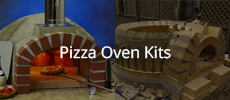I've been meaning to build this graphic for some time, and got around to it this weekend. The graphic below is a visual representation of how heat moves, and is stored in both a Forno Bravo pizza oven, and in a high mass bread oven. It's is based on my personal experience with a range of ovens, and reports from many owners of various types of ovens.
There are a number of things that the graphic tries to capture, including:
1. Why higher mass ovens require longer firing periods.
2. Why insulation is so important to the traditional pizza oven -- as it comes in constant contact with high-heat on the outer edge of the oven chamber and floor.
3. Why a pizza can maintain high heat while cooking a large number of pizzas.
4. Why all wood-fired ovens, and most noteably bread ovens need time for the termperature to regulate before you bake bread.
5. Why a high mass oven actually starts to cool down inside the oven chamber when you start cooking pizzas -- those BTUs are still filling up the rest of the oven chamber mass.
Let me know if the graphic helps make this more clear.
James
There are a number of things that the graphic tries to capture, including:
1. Why higher mass ovens require longer firing periods.
2. Why insulation is so important to the traditional pizza oven -- as it comes in constant contact with high-heat on the outer edge of the oven chamber and floor.
3. Why a pizza can maintain high heat while cooking a large number of pizzas.
4. Why all wood-fired ovens, and most noteably bread ovens need time for the termperature to regulate before you bake bread.
5. Why a high mass oven actually starts to cool down inside the oven chamber when you start cooking pizzas -- those BTUs are still filling up the rest of the oven chamber mass.
Let me know if the graphic helps make this more clear.
James





 Does it seem right to you?
Does it seem right to you?
Comment